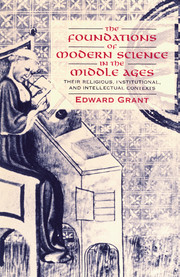 The Foundations of Modern Science in the Middle Ages
The Foundations of Modern Science in the Middle Ages Book contents
- Frontmatter
- Contents
- Preface
- 1 THE ROMAN EMPIRE AND THE FIRST SIX CENTURIES OF CHRISTIANITY
- 2 THE NEW BEGINNING: THE AGE OF TRANSLATION IN THE TWELFTH AND THIRTEENTH CENTURIES
- 3 THE MEDIEVAL UNIVERSITY
- 4 WHAT THE MIDDLE AGES INHERITED FROM ARISTOTLE
- 5 THE RECEPTION AND IMPACT OF ARISTOTELIAN LEARNING AND THE REACTION OF THE CHURCH AND ITS THEOLOGIANS
- 6 WHAT THE MIDDLE AGES DID WITH ITS ARISTOTELIAN LEGACY
- 7 MEDIEVAL NATURAL PHILOSOPHY, ARISTOTELIANS, AND ARISTOTELIANISM
- 8 HOW THE FOUNDATIONS OF EARLY MODERN SCIENCE WERE LAID IN THE MIDDLE AGES
- Notes
- Bibliography
- Index
1 - THE ROMAN EMPIRE AND THE FIRST SIX CENTURIES OF CHRISTIANITY
Published online by Cambridge University Press: 05 June 2012
- Frontmatter
- Contents
- Preface
- 1 THE ROMAN EMPIRE AND THE FIRST SIX CENTURIES OF CHRISTIANITY
- 2 THE NEW BEGINNING: THE AGE OF TRANSLATION IN THE TWELFTH AND THIRTEENTH CENTURIES
- 3 THE MEDIEVAL UNIVERSITY
- 4 WHAT THE MIDDLE AGES INHERITED FROM ARISTOTLE
- 5 THE RECEPTION AND IMPACT OF ARISTOTELIAN LEARNING AND THE REACTION OF THE CHURCH AND ITS THEOLOGIANS
- 6 WHAT THE MIDDLE AGES DID WITH ITS ARISTOTELIAN LEGACY
- 7 MEDIEVAL NATURAL PHILOSOPHY, ARISTOTELIANS, AND ARISTOTELIANISM
- 8 HOW THE FOUNDATIONS OF EARLY MODERN SCIENCE WERE LAID IN THE MIDDLE AGES
- Notes
- Bibliography
- Index
Summary
During the first four centuries of Christianity, the Roman Empire was a geographical colossus, extending from the Atlantic Ocean in the west to Persia in the east, and from Britain in the north to regions south of the Mediterranean Sea. Within this Greco-Roman world, Christianity was born and disseminated. Its birth and early development occurred in a period of vast religious change and economic upheaval. For the first two hundred years of its existence, Christianity was no more visible and noticeable than many other of the numerous mystery religions and cults that had proven attractive to people at all levels of society. The sense of comfort that pagans derived from their belief in the traditional Homeric and Roman gods of the state religions was disappearing. The new cults – for example, Isis, Mithras, Cybele, and Sol Invictus (Unconquered Sun), as well as Gnosticism and Christianity – that were replacing the traditional deities not only borrowed ideas and rituals from one another but also came to share a few basic beliefs. The world was evil and would eventually pass away. Humans, sinful by nature, could achieve never-ending bliss only if they turned away from the things of this world and cultivated those of the eternal spiritual realm. Along with practicing varying degrees of asceticism, many of the cults believed in a redeemer god who would die in order to bring eternal life after death to his faithful followers.
- Type
- Chapter
- Information
- The Foundations of Modern Science in the Middle AgesTheir Religious, Institutional and Intellectual Contexts, pp. 1 - 17Publisher: Cambridge University PressPrint publication year: 1996


